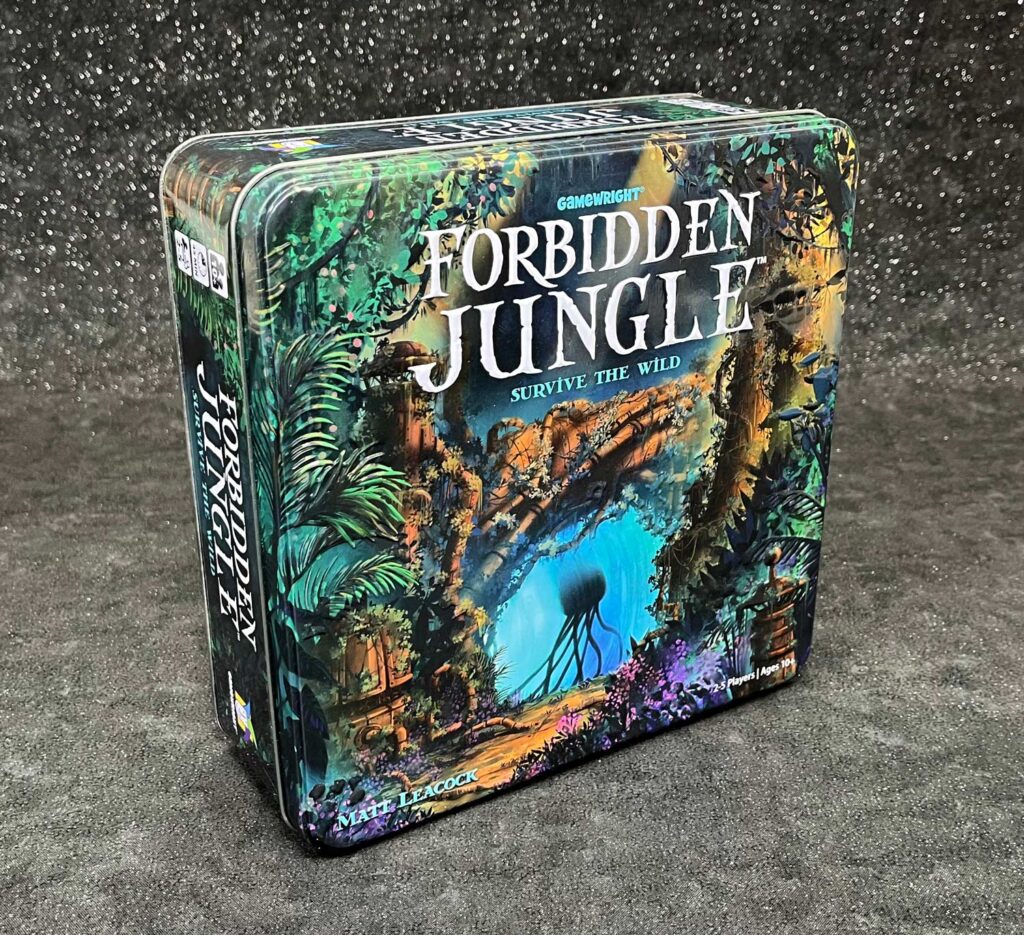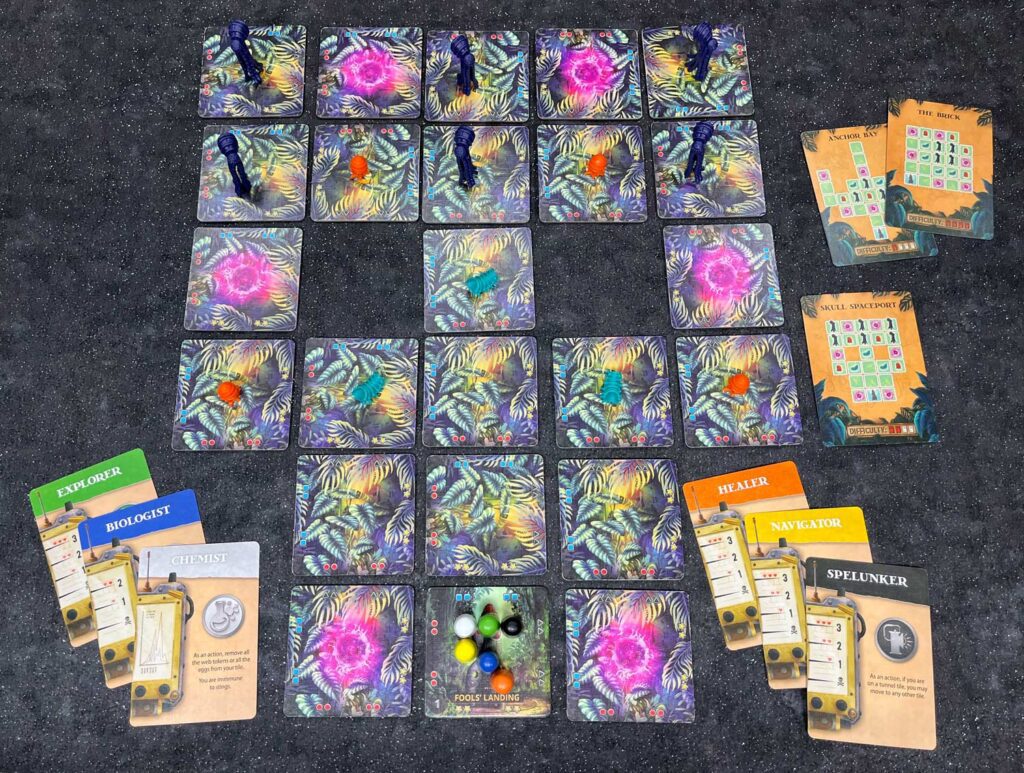Disclosure: Meeple Mountain received a free copy of this product in exchange for an honest, unbiased review. This review is not intended to be an endorsement.
Back in 2010 Matt Leacock was fresh off the release of Pandemic—one of the first, and definitely one of the most successful, cooperative games in the world. I don’t know his motivation, but I think he wanted another cooperative game that was perhaps a bit simpler and more family friendly. And thus Forbidden Island was born. It used a similar framework as Pandemic: multiple, distinct player roles (each with their own special abilities); a card driven system which both advanced the game and provided benefits and penalties to players; and a goal (rescue 4 artifacts and get on the helicopter before the island sank).
Two other Games in the Forbidden series have been released: the excellent and challenging Forbidden Desert, and the less-than-stellar Forbidden Skies. And now Gamewright Games has released the 4th title in the series, and I’m pleased to tell you that Forbidden Jungle is a return to the formula which made the first two titles so successful.

You know where you are? You’re in the jungle, baby.
In Forbidden Jungle, 2-5 players attempt to search and conquer an alien jungle landscape in search of four crystals which will powe the portal—which you must also find—escape through. All the while, you must avoid the deadly spiders, along with their hatchlings and webs. Forbidden Jungle will feel familiar to fans of the previous games, without making you feel like you’re doing the same thing over again.
Forbidden Jungle Setup
As with the first two games in the series, Forbidden Jungle is tile based. Gamewright has provided a number of different recommendations for layout, which help you adjust the complexity to your liking. Select your preferred layout, then follow the instructions on where to place all the pieces. You’ll be arranging crystal tiles, the landing pad, along with spiders, hatchlings, and eggs.
Once you’re done, determine which role each player will assume, and you’re ready to start.
A note: the game recommends that you shuffle the roles and distribute them randomly; but some roles are clearly more useful than others. So I’d recommend picking the ones you want to use for your first game, then passing those out randomly.

Forbidden Jungle Components
Since the tiles are at the heart of the game, let’s take a quick look at some of the tiles you’ll be uncovering.

There are three main types of tiles, each with an “explored” and “unexplored” side.
Fools Landing (1) – Where you land, ultimately unimportant, but your explorers will all start here.
Crystal Tiles (6) – 4 of these will be “powered”, the other 2 are “unpowered”. You’ll need to arrange the 4 powered crystals around a portal to escape.
Jungle Tiles (17) – These tiles are a mix of spider nests, tunnels, machines, and portals.
All tiles have one thing in common, around the edges you’ll see colored shapes (black, red, blue, and yellow). It’s these shapes that dictate movement of creatures around the board, and how they will interact with the players—more on that in a bit.
Lastly, there are two decks of cards: Equipment cards, which provide powerful abilities to players, and the Threat deck, which triggers actions like when (and where) spiders will move, when new creatures are placed onto the board, and when tiles are destroyed.
You learn to live like an animal, In the jungle where we play
A turn in Forbidden Jungle plays out in a very similar fashion to the other games–each player has a base of X actions, although some roles might have more. You can move, help other players, and interact with the surroundings by flipping over tiles to search, defeating enemies, and moving tiles around.
So instead of rehashing the basics, let’s talk about what makes Forbidden Jungle different. Sprinkled throughout the Threat deck are cards which make the environment come alive and actively attack you.
Creatures
Move Hatchlings & Adults – There are 4 of these cards in the deck, one for each color matching the icons on jungle tiles. All hatchlings and adults move from their current tile, in the direction of that color. Any players on the destination tile are stung by adults and lose health; and of course if anyone drops to zero health, the game is over for all players.
Adults Spin Webs – Again, there are 4 of these cards in the deck. All adults spin a web in the direction of the card’s color. Place a web token across the space between two tiles. This not only blocks movement between those tiles but also prevents you from exploring that tile (flipping it over).

In addition to these cards, there are cards which cause adults to lay eggs, eggs to grow into hatchlings, and hatchlings to grow into adults. There are also cards which cause eggs, hatchlings, and adults to enter the game via tunnels, nests, and even the portals you’re so desperately searching for.
In true co-op game fashion, if there’s ever a time in which you need to place any creature tokens on the game board and you can’t, you lose. But even the best laid plans are sometimes no match for the Threat deck’s randomness.
Tiles
The only way you’re to win this game is by exploring—moving to, and flipping over, jungle tiles until you’ve found powered crystals, at least one portal and, more importantly, a Configurator. Since your goal is to place powered crystals on all 4 sides of a portal, you’ll have to move tiles around. And that’s where the Configurator comes in. As an action, you can move any tile on the board, any number of spaces in one direction. There are also tiles which allow you to “blow up” tiles on the board to make room for your machinations. There are several other machines for your use, but the Configurator is the most important and useful one.
The Jungle Collapses
Finally, one other difference (yet similarity) is that some Threat cards cause jungle cards to collapse. This is similar to the sinking mechanism in Forbidden Island, but used to better effect here, in my opinion. When the Collapse card is revealed, you don’t remove a specific tile; you remove a revealed jungle tile with the lowest printed number. The first one will always be Fools Landing, but for the rest of the game, this will be wholly dependent on which tiles you’ve revealed. And don’t think that the “important” tiles will have higher numbers…sometimes when a Collapse happens you might lose a portal (thankfully there are 4), or a machine. And hopefully you don’t lose a powered crystal, because if that happens you lose the game.
Watch it bring you to your knees
Let me start off by saying that playing Forbidden Jungle was like greeting an old friend. I love Forbidden Island, it’s a great way to introduce cooperative gaming to people, it plays fast, it’s relatively challenging, and the components are great (except for that stupid tin). And I’m happy to say that Forbidden Jungle has the same sort of feel–even though it’s different enough for you to own both, should you want to do so.
I love the new elements of the game. he creatures are maddening because they literally crawl out from under rocks and tunnels, they spin webs and move in unpredictable directions, and generally make the game harder. But they also provide some really satisfying moments. For example, one of the machines you can reveal is the Compeller, which allows you to move all adults and hatchlings on any one tile, in one direction. In one game I was able to move a number of creatures in a row directly onto the Electrifier (another machine) which immediately destroys them. I felt like the Pied Piper of the Jungle. We all cheered and clapped.
I also really appreciate the way players can rearrange the jungle to their needs. It’s like one of those sliding puzzles that you could never solve as a kid. Except in this case, if you can’t make the puzzle work, you can literally just destroy a tile to make room. And bonus points if you use the Compeller to move creatures onto that tile before you destroy it!
There are only a few annoyances to be found here. First of all, the tin. any many things have been said about the metal tins these games come in. I don’t like them, and I wish there was a box. Also, the legs on the adult spiders are too close together, which means they have trouble standing up. You can fix it temporarily by pulling them apart. But the plastic is soft and just returns to shape after a few minutes. It’s not a big problem, but it’s annoying to have to fix them every so often. Honestly, that’s about it. There might be things that bother other people, but I’m not quite as picky with games that I know I’m not going to play dozens of times.
If you’re wondering where this game falls in difficulty, let me start off by saying that we lost our first three games…even though we used the beginner’s difficulty. There’s definitely a bit of a ramp up in learning how the game works, knowing how the creatures move, what each tile can do, and the randomness of the jungle’s layout. I’d say that Forbidden Jungle falls somewhere between Forbidden Island and Forbidden Desert—although you can increase the difficulty in Forbidden Jungle by changing the layout of the tiles. Try putting Fools Landing on one end of the board, or by moving crystal tiles into odd places to make reaching and exploring them more difficult. It’s all up to you.
So is Forbidden Jungle worth getting? I’d say yes, especially if you like challenging tricky puzzles, with some uncertainty and randomness thrown in.











